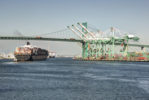
Visit Our Sponsors |
|
|
|
|
|
|
|
|
|
|
|
|
|
|
|
|
|
|
|
|
|
|
|
|
|
|
|
|
|
|
|
|
|
|
|
|
|
|
This was better than expected as demand for newbuilds suffered a knock from the second quarter of 2011 onwards, with production significantly curtailed from that point. Indeed, analysis implies that up to 70 percent of 2011 net additions were made in the first six months of the year, highlighting distinct uneven progress.
The underlying reason for the slowdown in the latter half of 2011 was an apparent misreading of demand. Few buyers predicted an over-supply (900,000 TEUs at mid-2011, and over 500,000 TEUs at the end of 2011) that was exacerbated by a weak peak season. Even so, utilisation of the in-service fleet held at a very high level, topping 95 percent.
One effect of high utilisation is that container-to-slot operating levels have dropped to historic lows, close to 1.8:1 in 2010/11 compared to 2:1 immediately preceding 2009. This has been achieved by shipping companies working their assets harder, which considering the increasing container dwell times resulting from slow steaming, is something of an achievement. Andrew Foxcroft, author of the Container Census report, forecasts annual container fleet growth will be in the order of 7 percent from 2012-2015 as shipping companies continue to adopt a tight container/slot operating ratio, whilst also increasing replacement purchase in comparison to 2010-2011.
Fleet growth since 2009 has continued to be dominated by leasing companies who have posted growth (TEUs) of 10.6 percent in 2011 and 9 percent in 2009, compared to shipping lines and other transport companies only registering 7 percent and 5.7 percent. Investment by shipping lines in particular was curtailed when their profits slumped and debts rose. However, some lines have tentatively resumed equipment investment, but they are still very much testing the waters.
Newbuild dry freight pricing has continued volatile, thereby affecting the calculated capital equipment unit (CEU) valuation and new-for-old replacement cost of the global container fleet. Dry freight prices attained their greatest height (almost $3,000 per CEU) in early 2011, by which time the replacement cost of the global fleet was up by more a third on its level at the start of 2010. However, the fleet's corresponding CEU valuation was down slightly because the sharp upward movement of dry freight prices contrasted with the more static level of reefer/tank pricing.
Throughout 2011, the reverse occurred. CEU values increased, as against no real change in the fleet's replacement cost. This was due to an overall 20-percent fall in dry freight pricing against the continued static level of reefer/tank costs. The dry freight price was subsequently to recover by 20 percent during the first half of 2012 (to $2,750 per CEU), before going into decline again. Foxcroft nevertheless states that, "The outlook is for pricing to stay high, with the annualised forecast holding at $2,500 for 2012 and 2013."
The report will be available in PDF format, which can be downloaded from the Drewry website at a cost of £1295.
Source: Drewry Maritime Research
RELATED CONTENT
RELATED VIDEOS
Timely, incisive articles delivered directly to your inbox.






